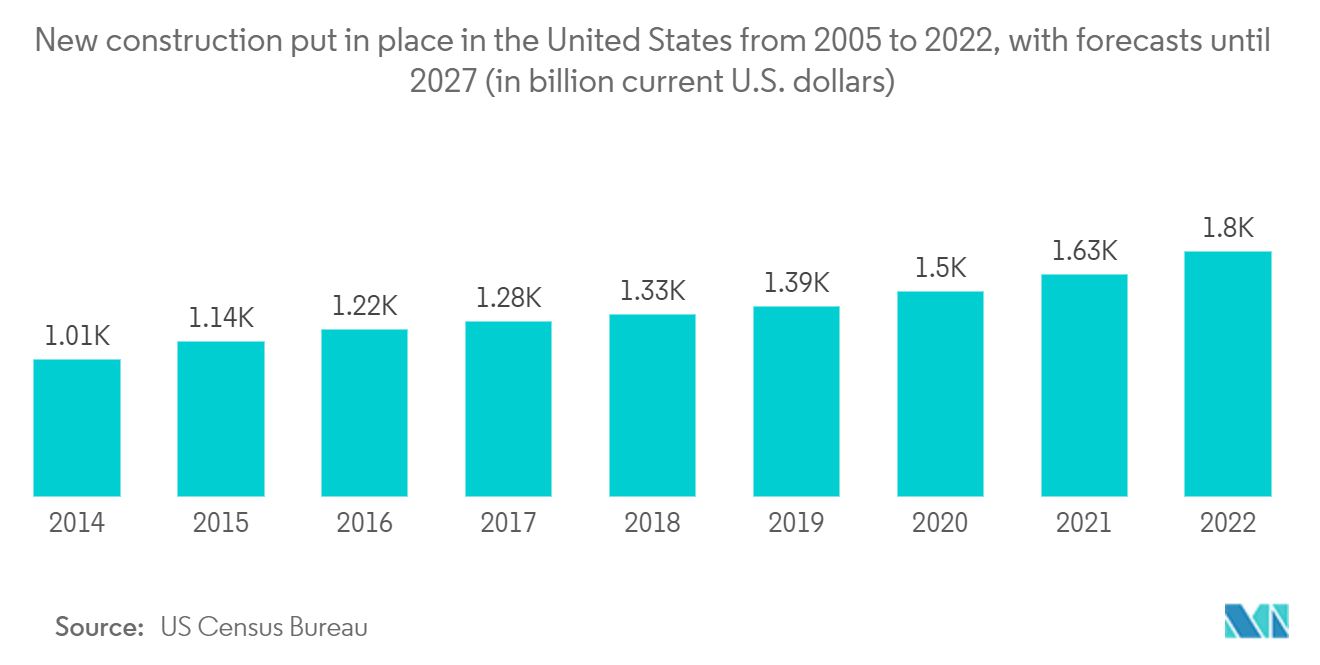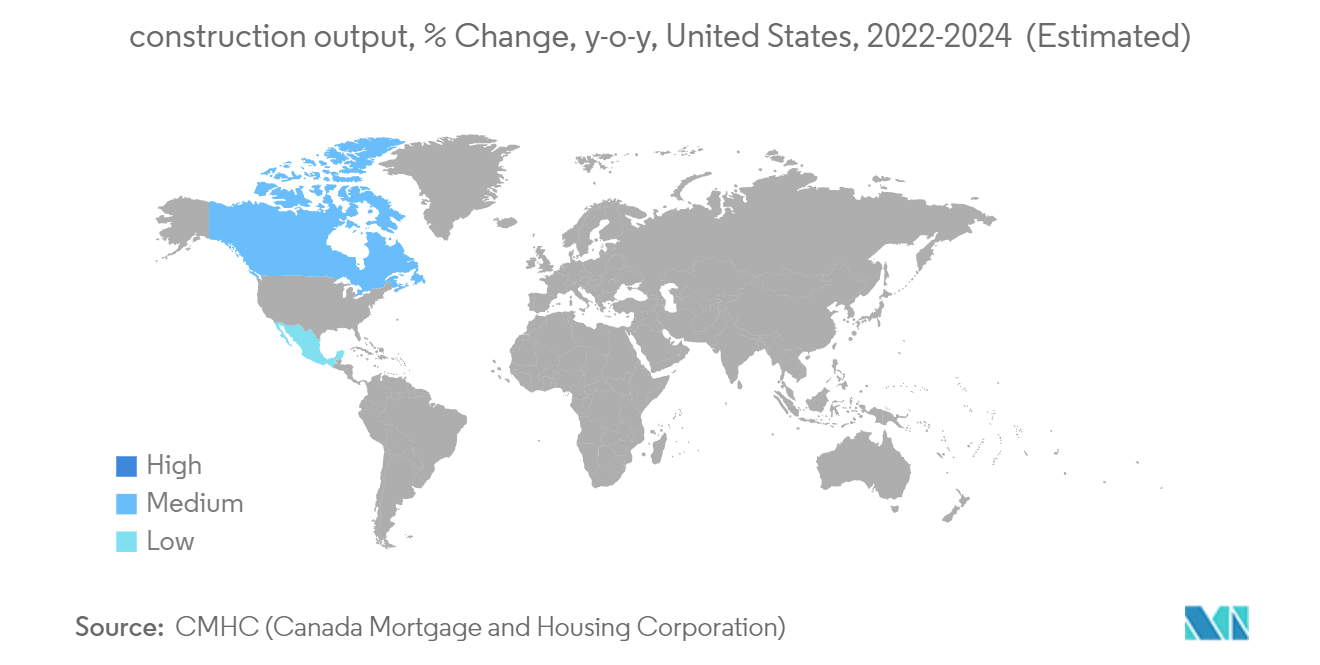Market Trends of North America Construction Industry
Residential construction segment holds the major share in the market
- Residential construction, already reeling from rising mortgage rates, will continue to contract and will be joined by nonresidential construction as the commercial sector retrenches. The funds provided to the construction industry through the Infrastructure Investment and Jobs Act (IIJA), the CHIPS and Science Act, and the Inflation Reduction Act (IRA) will counter the downturn, allowing the construction [industry] to tread water.
- During the Great Recession, there was no place to find solace in construction activity; 2023 will be quite different. Rising interest rates put the brakes on what was a robust housing market in early 2022. Some growth but much slower.’ If one breaks that out by quarter, it is expected that there will be a small negative in the first half of 2023 but pick up growth in the second half of 2023.
- Wages should continue to rise in 2023-2024, with a labor market remaining tight (the economy showed full employment in 2022). That is a reason the Fed stands a chance in terms of navigating this narrow path of slowing without a recession.
- The US housing market has borne the brunt of the interest rate hikes amid efforts by the Federal Reserve (Fed) to tame inflation. The Fed announced its ninth straight interest rate hike of 25 basis points in March 2023. With this move, it increased the federal funds rate from nearly 0% in March 2022 to a range of 4.75-5%. The Fed is likely to hike rates further by 25 basis points in early May 2023, as the job market continues to remain tight and inflation is still at higher levels despite easing in recent months.
- Considering the surge in mortgage rates, high construction costs, supply chain disruptions, labor shortages, and fall in permits for new privately owned housing units, market experts expect the US residential construction sector to remain weak in 2023. Reflecting the current weakness in the housing sector, housing construction starts fell sharply in the first three months of 2023.
- According to the US Census Bureau, the total number of new privately owned housing units on which construction started in the country (measured in unadjusted terms) plummeted by 17.9% YoY in the first quarter (Q1) of this year, falling from 389,700 units in Q1 2022 to 319,800 units in Q1 2023. This weakness is attributed to a fall in construction starts of one-unit houses (-28.6% YoY) and two-to-four-unit houses (-31.8%); in contrast, housing construction started on houses with five-or-more units rose by 6.4% YoY in Q1 2023.

United States holds the future market growth in the coming year
- US construction output is forecast to contract by 5% in 2023, mainly due to a slump in residential construction. Rising interest rates lead to higher costs of project financing, while inflation has increased construction material costs. Supply of skilled workers and supply chain disruptions have led to longer lead times with project delays. The lack of skilled labor and an aging workforce could curtail potential construction output in the future.
- It is expected that the residential building segment to see the largest contraction because aggressive monetary tightening is feeding into higher mortgage rates, and high inflation weighs on the affordability of homeownership. However, non-residential construction remains more resilient due to government stimulus. The Infrastructure Investment and Jobs Act will provide a stimulus for construction this year, aiming at comprehensive investments in aging infrastructure (including roads, highways, bridges, rail, and broadband development).
- Construction activities in the US residential sector started on a weaker note in 2023, with the total value of construction put in place (measured in seasonally adjusted nominal terms) falling by 4.1% year-on-year (Y-o-Y) in the first two months of 2023. Due to the economic slowdown, subdued demand in residential construction, and rising pressure on margins, it is expected that both payment delays and insolvencies will increase in 2023. With high-interest rates and a slowdown in activity, businesses with limited liquidity and/or elevated debt levels will face difficulties in servicing their obligations.
- Given the more subdued credit management situation and business performance of the construction industry, the sector outlook has been downgraded from “Good” to “Fair.”Privately‐owned housing units authorized by building permits in April 2023 were at a seasonally adjusted annual rate of 1,416,000. This is 1.5 percent below the revised March rate of 1,437,000 and 21.1 percent below the April 2022 rate of 1,795,000.
- Single‐family authorizations in April were at a rate of 855,000; this is 3.1 percent above the revised March figure of 829,000. Authorizations of units in buildings with five units or more were at a rate of 502,000 in April 2023. Privately‐owned housing starts in April were at a seasonally adjusted annual rate of 1,401,000. This is 2.2 percent (±11.9 percent)* above the revised March estimate of 1,371,000 but is 22.3 percent (±8.7 percent) below the April 2022 rate of 1,803,000.
- Single‐family housing starts in April 2023 were at a rate of 846,000; this is 1.6% (±12.3%) above the revised March 2023 figure of 833,000. The April rate for units in buildings with five units or more was 542,000. Privately‐owned housing completions in April were at a seasonally adjusted annual rate of 1,375,000. This is 10.4% (±9.9%) below the revised March estimate of 1,534,000 but is 1.0% (±16.4%) above the April 2022 rate of 1,361,000. Single‐family housing completions in April were at a rate of 971,000; this is 6.5% (±11.0%) below the revised March rate of 1,039,000. The April rate for units in buildings with five units or more was 400,000.

